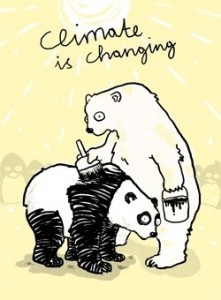Sunshine coupled with cool breezes makes for a fall-like late-afternoon Saturday here in California’s Central Valley — near perfect for tomorrow’s fall-back day.
Meanwhile, on the subject of climate and its corresponding weather, COP26 continues in Glasgow, Scotland, where today there was more excitement and news from outside the conference rooms as thousands took to the streets in heavy rain and wind to protest the wimp, lackluster action taken so far by the conference attendees — yesterday, Swedish climate activist Greta Thunberg called out the adults in charge:
“It is not a secret that COP26 is a failure,” Thunberg told thousands of mainly young protesters that had gathered in the Scottish city.
“This is no longer a climate conference. This is now a global greenwashing festival.”She hit out at delegates from 200 countries who had got together to work out how to meet the goals of the Paris Agreement to limit climate change across the globe.
“They cannot ignore the scientific consensus and they cannot ignore us,” said Thunberg.
“Our leaders are not leading. This is what leadership looks like,” she said, pointing to the crowd.The founder of Fridays for Future said leaders of the Global North seemed to be trying to prevent any real change.
“They are actively creating loopholes and shaping frameworks to benefit themselves and to continue profiting from this destruction,” she said.
“We need immediate drastic annual emission cuts unlike anything the world has ever seen.”
And today back in the streets:
A good wrap on the protests vs conference attendees, especially the G20 elites, comes from Somini Sengupta at The New York Times this afternoon:
The week began with more than 130 presidents and prime ministers posing for a group photo in a century-old Baroque museum.
Their median age: over 60.
The week ended with boisterous protests on the streets of Glasgow. A march on Friday was led by activists, some barely old enough to vote in their countries, who accused world leaders of wasting what little time remains to safeguard their future.These bookends to the first week of the climate summit in Scotland reveal a widening divide that threatens to grow larger.
Those with the power to make decisions about how much the world warms in the coming decades are mostly old and male. Those who are angriest about the pace of climate action are mostly young and female.
The two sides have vastly divergent views of what the summit should achieve.
Indeed, they seem to have different notions of time.At the summit, leaders are setting goals for 2030 at the earliest.
In some cases, they’re setting targets for 2060 and 2070, when many of today’s activists will be hitting retirement age.The activists say change must come immediately. They want countries to abruptly stop using fossil fuels and to repair the climate damage that is now being felt in all corners of the globe but is especially punishing the most vulnerable people in the Global South.
For them, midcentury is an eternity.“Now is the time. Yesterday was the time,” is how Dominique Palmer, 22, an activist with Fridays for Future International, put it during a panel discussion at The New York Times Climate Hub on Thursday.
“We need action right now.”Social movements have almost always been led by young people. But what makes the climate movement’s generational divide so pointed — and the fury of the young so potent — is that world leaders have been talking about the need to address climate change since before most of the protesters were born.
And in the streets the reality: ‘There was also despair; Chris Cornroy, 37, who works for Oxfam, said: “The world is probably going to end within our lifetime, so any difference you can make counts. But I don’t think anything will be achieved from this if I’m being honest. I don’t think anything will make a positive difference today.”‘
In passing context, and illustrating the major worldwide hurdle/problem facing getting into gear strong climate change action –more of the “blah, blah, blah.” The rich keep backtracking — from Bloomberg Green last Thursday:
A key African climate group called for a 13-fold increase in finance from rich nations to help poorer countries make the green transition and protect their economies from the worst impacts of global warming.
The African Group of Negotiators on Climate Change wants $1.3 trillion of finance a year made available from 2025, according to the bloc’s chair Tanguy Gahouma-Bekale. That compares with a decade-old target of $100 billion that was supposed to be reached by 2020, but has been repeatedly missed.
…
“We need to take action and we need support to reflect the real cost of climate change,” Gahouma-Bekale said in an interview at the COP26 summit.
“The $100 billion was a pledge from more than 10 years ago. It’s already absurd.”
Farcical in extreme.
Yet, once again, here we are…
 (Illustration out front by Handoko Tjung, found here)
(Illustration out front by Handoko Tjung, found here)